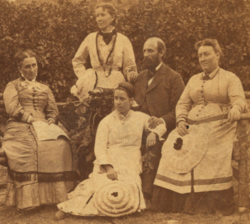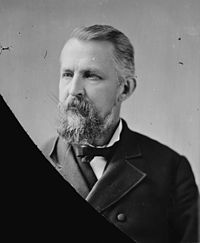Edmunds–Tucker Act
 | |
| Other short titles | Anti-Plural Marriage Act of 1887 |
|---|---|
| Long title | An Act to amend an act entitled "An act to amend section fifty-three hundred and fifty-two of the Revised Statutes of the United States, in reference to bigamy, and for other purposes," approved March twenty-second, eighteen hundred and eighty-two. |
| Nicknames | Anti-Polygamy Act of 1887 |
| Enacted by | the 49th United States Congress |
| Effective | March 3, 1887 - November 2, 1978 |
| Citations | |
| Public law | 49-397 |
| Statutes at Large | 24 Stat. 635 |
| Codification | |
| Titles amended | 48 U.S.C.: Territories and Insular Possessions |
| U.S.C. sections created | 48 U.S.C. ch. 10 § 1480 |
| Legislative history | |
| |
| Mormonism and polygamy |
|---|
 |
|
|
The Edmunds–Tucker Act of 1887 was an Act of Congress that restricted some practices of the Church of Jesus Christ of Latter-day Saints (LDS Church) and disincorporated the LDS Church. An amendment to the earlier Edmunds Act, it was passed in response to the dispute between the United States Congress and the LDS Church regarding polygamy. The act was found at 48 U.S.C. § 1480, with the full text of the law published at 24 Stat. 635. In 1978, the act was repealed by Public Law 95-584, the full text of which was published at 92 Stat. 2483. [1][2]
The act was named after its congressional sponsors, Senator George F. Edmunds of Vermont and Congressman John Randolph Tucker of Virginia.
Legislative history
[edit]In President Grover Cleveland's annual address to Congress in December 1885, he emotionally discussed the issue of polygamy in Utah:
The strength, the perpetuity, and the destiny of the nation rest upon our homes, established by the law of God, guarded by parental care, regulated by parental authority, and sanctified by parental love.
These are not the homes of polygamy. . . .
There is no feature of this practice or the system which sanctions it which is not opposed to all that is of value in our institutions.
There should be no relaxation in the firm but just execution of the law now in operation, and I should be glad to approve such further discreet legislation as will rid the country of this blot upon its fair fame.
Since the people upholding polygamy in our Territories are reenforced by immigration from other lands, I recommend that a law be passed to prevent the importation of Mormons into the country.[3][4]
The Act was passed by the Senate in January 1886 by a vote of 38–7. It was passed by the House via a voice vote in January 1887. President Cleveland refused to sign the bill but did not veto it, which meant that the Act became law on March 3, 1887.[5]
Provisions
[edit]The act disincorporated both the LDS Church and the Perpetual Emigration Fund on the grounds that they fostered polygamy. The act prohibited the practice of polygamy and punished it with a fine of from $500 to $800 and imprisonment of up to five years. It dissolved the corporation of the church and directed the confiscation by the federal government of all church properties valued over a limit of $50,000. The act was enforced by the U.S. Marshal and a host of deputies.
The act:
- Disincorporated the LDS Church and the Perpetual Emigrating Fund Company, with assets to be used for public schools in the Territory.[6]
- Required an anti-polygamy oath for prospective voters, jurors and public officials.
- Annulled territorial laws allowing illegitimate children to inherit.
- Required civil marriage licenses (to aid in the prosecution of polygamy).
- Abrogated the common law spousal privilege for polygamists, thus requiring wives to testify against their husbands.[7]
- Disenfranchised women (who had been enfranchised by the Territorial legislature in 1870).[8]
- Replaced local judges (including the previously powerful Probate Court judges) with federally appointed judges.
- Abolished the office of Territorial superintendent of district schools, granting the supreme court of the Territory of Utah the right to appoint a commissioner of schools. Also called for the prohibition of the use of sectarian books and for the collection of statistics of the number of so-called gentiles and Mormons attending and teaching in the schools.[9]
(See text of the act scanned from the U.S. Statutes at large, linked elsewhere on this page.)
In 1890 the U.S. Supreme Court upheld the seizure of Church property under the Edmunds–Tucker Act in Late Corp. of the Church of Jesus Christ of Latter-Day Saints v. United States.
This act was repealed in 1978.[10][11]
Edmunds–Tucker Act sponsors
[edit]See also
[edit]- 1890 Manifesto
- The Church of Jesus Christ of Latter-day Saints and politics in the United States
- Edmunds Act (1882)
- Timeline of civil marriage in the United States
- LDS Church v. United States (1890)
- Morrill Anti-Bigamy Act (1862)
- Poland Act (1874)
- Reynolds v. United States (1879)
- Second Manifesto (1904)
- Smoot Hearings (1903–1907)
- Utah War (1857–1858)
- Women's suffrage in Utah
References
[edit]- ^ "Repeal of Law Establishing Limits on Land which Certain Religious Corporations hold in any United States Territory - P.L. 95-584" (PDF). 92 Stat. 2483. U.S. Government Printing Office. November 2, 1978.
- ^ "Repeal of Law Establishing Limits on Land which Certain Religious Corporations hold in any United States Territory - Senate Bill 3371". Congress.Gov. Library of Congress. August 2, 1978.
- ^ Grover Cleveland. First Annual Message to Congress (first term), December 8, 1885. http://www.presidency.ucsb.edu/ws/index.php?pid=29526
- ^ M. Paul Holsinger, "Henry M. Teller and the Edmunds-Tucker Act". The Colorado Magazine, vol 48 no 1, Winter 1971, p. 3. http://www.historycolorado.org/sites/default/files/files/Researchers/ColoradoMagazine_v48n1_Winter1971.pdf Archived 2016-10-22 at the Wayback Machine
- ^ M. Paul Holsinger, "Henry M. Teller and the Edmunds-Tucker Act". The Colorado Magazine, vol 48 no 1, Winter 1971, p. 12-13. http://www.historycolorado.org/sites/default/files/files/Researchers/ColoradoMagazine_v48n1_Winter1971.pdf Archived 2016-10-22 at the Wayback Machine
- ^ L. Rex Sears, "Punishing the Saints for Their "Peculiar Institution": Congress on the Constitutional Dilemmas," 2001 Utah L. Rev. 581
- ^ Embry, Jessie L. (1994), "Polygamy", in Powell, Allan Kent (ed.), Utah History Encyclopedia, Salt Lake City, Utah: University of Utah Press, ISBN 0874804256, OCLC 30473917, archived from the original on 2017-04-17, retrieved 2013-10-30
- ^ Women's Suffrage in Utah Archived 2012-11-23 at the Wayback Machine Jean Bickmore White, Utah History Encyclopedia
- ^ Edmunds–Tucker Act: Section 25
- ^ The practice of polygamy: legitimate free exercise of religion or legitimate public menace? Revisiting Reynolds in light of modern constitutional jurisprudence Richard A. Vazquez, Journal of Legislation & Public Policy (New York University School of Law), Volume 5, Number 1, Fall 2001
- ^ Past and Present Proposed Amendments to the United States Constitution Regarding Marriage Archived 2010-06-06 at the Wayback Machine Edward Stein, Washington University Law Quarterly, Volume 82, Number 3, 2004
Further reading
[edit]- "Gospel Topics: The Manifesto and the End of Plural Marriage", churchofjesuschrist.org, LDS Church, retrieved 2014-10-22
- Peters, Gerhard; Woolley, John T. "Grover Cleveland: "First Annual Message (first term)," December 8, 1885". The American Presidency Project. University of California - Santa Barbara.
- Peters, Gerhard; Woolley, John T. "Benjamin Harrison: "Proclamation 346 - Granting Amnesty and Pardon for the Offense of Engaging in Polygamous or Plural Marriage to Members of the Church of Latter-Day Saints," January 4, 1893". The American Presidency Project. University of California - Santa Barbara.
- Peters, Gerhard; Woolley, John T. "Grover Cleveland: "Proclamation 369 - Granting Amnesty and Pardon for the Offenses of Polygamy, Bigamy, Adultery, or Unlawful Cohabitation to Members of the Church of Latter-Day Saints," September 25, 1894". The American Presidency Project. University of California - Santa Barbara.
- 1887 in American law
- 1887 in Christianity
- 49th United States Congress
- History of the Church of Jesus Christ of Latter-day Saints
- United States law and polygamy in Mormonism
- The Church of Jesus Christ of Latter-day Saints in the United States
- United States federal territory and statehood legislation
- Repealed United States legislation
- Utah Territory
- 19th-century Mormonism
- United States legislation about religion
- Christianity and law in the 19th century
- Women's suffrage in Utah



